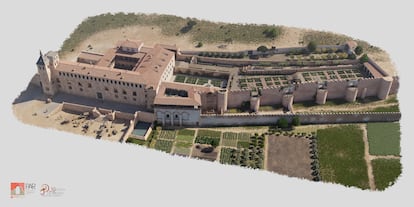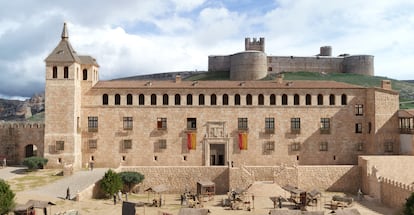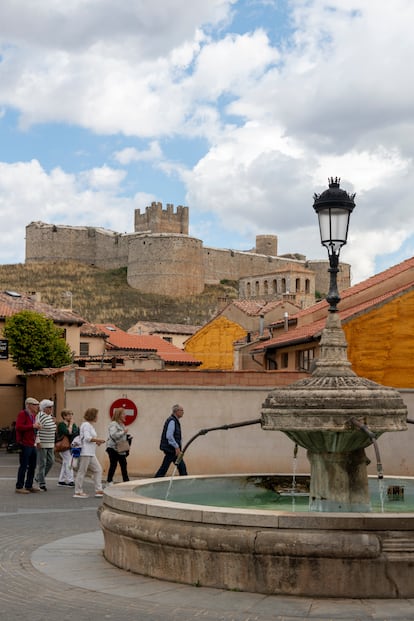On January 11, 1811, Napoleonic troops set fire to one of the most beautiful Renaissance palaces in the Castiles, that of the Marquises of Berlanga, in Berlanga del Duero (Soria). Three centuries of history thus disappeared under the flames and gave way to apathy and abandonment of its architectural remains, which today do not go beyond an impressive 52-meter-long façade and a large tower.
The one that became an obligatory stop for kings and queens of Spain on their trips through the north of the peninsula – Felipe II and his wife Isabel de Valois, Felipe III, Felipe IV, Carlos II or the Infanta Clara Eugenia slept in its rooms – still conserves a breath of life thanks to the joint action of local, regional and national administrations, as well as the Association of Friends of Berlanga Castle. At the beginning of the month, the City Council approved a contract of 102,000 euros for the drafting of the project for its consolidation and restoration, which joins the two million awarded since 2023 by the Ministry of Transport and the Renacere Plan (Tourist Sustainability Plan in Destination granted to Berlanga) for rehabilitation. “We are trying to value it to attract visitors,” says Enrique Rubio, mayor of this municipality of 830 inhabitants located in what is known as emptied Spain.
Four years ago, the digital reconstruction of the Palace was achieved, which included the virtual recreation of its enormous gardens and orchards, fed by various hydraulic devices, its exterior and interior appearance, in addition to the formidable medieval castle (visitable and rehabilitated) that crowns the hill where the palace rises. Now the book A house is built by wisdom, and prudence is strengthened (inscription that is read above the main door of the building and translates as “with wisdom the house is built and with prudence it is preserved),” by archaeologist Roberto de Pablo Martínez, shows all the visible or non-visible secrets of this spectacular building . In addition to being a historical-artistic monument since 1980, it is an archaeological site, which includes remains of its walls, access doors, fountains, old churches or squares.

The palace is located within the monumental complex of the Berlanga castle, whose origin dates back to the 10th and 11th centuries, when the fortress was built on the top of the hill, which in the 14th century became the residence of the Tovar family. But at the beginning of the 16th century, the owners decided to abandon it and build a residence at its feet that, after various extensions and renovations, became the current palace. More than 70 meters of the fortress wall had to be demolished to accommodate it. In 1529 the works began. According to De Pablo Martínez, “more than a palace, it was a palace complex.” It would last three centuries.
But during the War of Independence, the French general Régis Barthélemy Mouton-Duvernet – who had suffered a heavy defeat against General José Durán and the priest Merino – decided to raze Berlanga. “There was harsh punishment against the town in which they looted the school and burned down the palace of the marquises and several stately homes. The flames devoured practically the entire building, leaving only the façade standing with its two towers (one of them ended up collapsing a century later) and some interior walls,” writes De Pablo. As a book of minutes from the City Council noted in 1811: “The Napoleonic soldiers made several raids through this country, they murdered Don Cecilio Belázquez, vicar priest of Caltojar (Soria, 58 inhabitants), and Bernabé Hernando, councilor who had just been from this town. , the neighbors having abandoned their houses, the palace-house of the most excellent Duke of Frías y of Uceda, Marquis, was looted by said troops and burned. of this town and six of the best of it in the square of the famous collegiate church.”

The various projects to rehabilitate it after the war were abandoned due to their very high cost. Thus, the theft or reuse of the palace stones that were still standing turned the majestic building into a complete ruin.
It was not until December 2001, when the Berlanga de Duero City Council managed to buy the monumental complex, which included the palace, for 365,000 euros. The consolidation and archaeological excavation work began, highlighting the remains of the building and creating a tourist office at its entrance. But this work continues, and the effort to recover, not a part, but the entire building is the objective of the town of Berlanga. “Its recovery is essential,” says the mayor of the Soria municipality. “We are very confident in our plan. It is an important element of our past and a building with which to claim our future,” concludes this graduate in Fine Arts.

